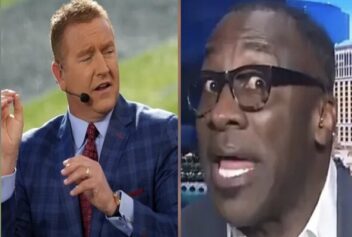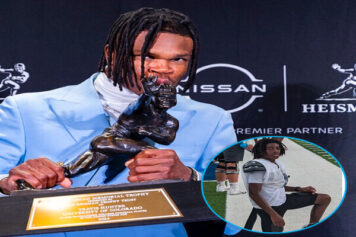Outside the state of Kansas, Bill Snyder is the unassuming man pacing the sidelines wearing a purple pullover and dark dress pants pulled up two inches past stylish. Even in the Wheat State where he has worked his coaching magic – the Miracle of Manhattan, even – he doesn’t ride shotgun.
Following Kansas State’s 24-19 road win over Big 12 favorite Oklahoma, the 72-year-old Snyder’s name bounced around with game's greats, and yet, most casual football fans would scarcely notice the purple-clad man if he were mowing his lawn next door. The Wildcats were the first ranked team to ever walk out of Norman as victors since Snyder’s former defensive coordinator Bob Stoops took over the Oklahoma program in 1999.
His reward: Continued anonymity. This is the product of doing business in The Little Apple.
Sure, Snyder’s name and likeness circulated the college football landscape this week, but it will not stay there for long. It never does. The man won 11 games six times from 1997 to 2003, and fans still couldn’t pick him out of a coaching lineup. He does not lob out juicy quotes. He does not battle with the media or throw camera crews out of practice. Snyder doesn’t fit any coaching archetype; we forget him because he is none other than himself.
So, looking back, how will Snyder’s achievements be evaluated? He never won a national title, but then again, he coached at KANSAS STATE – a program with an all-time winning percentage (.439) hovering below Hubert Davis’ career 3-point shooting mark. Snyder is 163-83-1 (.659) in 21 seasons, resurrecting a program so accustomed to losing that Barry Switzer called him “the coach of the century.”
This summer, ESPN’s Stats & Information department posted a study of the coaches which have had the greatest impact on their programs. Snyder ranked sixth on the list. Only one other man listed above him – Florida State’s Bobby Bowden – vied for national titles in the modern era of college football. And Snyder did it without the elite recruiting classes of his peers.
That’s rarified air Bill Snyder flies in around The Little Apple.
STIFF ARM SUSPECTS
The Suspects does not acknowledge name recognition, positional bias, team affiliation or media favorites for its weekly Heisman update. Players earn a spot based on production – and production alone – against quality opponents. This week a “hunting dog” leads the way, followed by a Hawaiian force of nature and a stat-padding quarterback too good to ignore.
E.J. Manuel, Florida State, QB: Slotting Geno Smith or De’Anthony Thomas as the Heisman frontrunner this week is to value name recognition – or “show dogs,” as Jimbo Fisher put it – over production in top-tier games. Manuel submitted a “Heisman moment” in a win over 10th-ranked Clemson, setting career highs in passing (380 yards) and rushing (102). Among players who have beaten a top-10 opponent, only Louisiana-Monroe (1-2) quarterback Kolton Browning has accounted for more offense than Manuel. Here's your helmet sticker, young man. Next game: South Florida
Manti Te’o, Notre Dame, LB: The Fighting Irish’s middle linebacker supplants Jarvis Jones as the lone defensive Suspect this week. Te’o ravaged another FBS opponent last Saturday – this time then-No. 18 Michigan — intercepting Denard Robinson twice to go along with seven tackles. The Hawaii product ranks fourth nationally with three interceptions, averages 9.5 tackles per game and was featured on Sports Illustrated's cover. He will need to keep playing at a high level if Notre Dame has any shot at staying undefeated. Next game: Miami
Geno Smith, West Virginia, QB: OK, The Suspects relents. Even though Maryland is the only FBS team Smith has faced this season, it’s tough to ignore 13 touchdowns in three games. Production and talent were not keeping Smith off this list in previous weeks – he’s second nationally in total offense (387.7 yards per game). But until he plays a quality opponent, it’s impossible to place him over Manuel. West Virginia’s Big 12 opener will reveal where Smith truly stands. Next game: No. 25 Baylor
Raising Suspicion: Braxton Miller (Ohio State); Jarvis Jones (Georgia); Stephon Tuitt (Notre Dame); Collin Klein (Kansas State); Le’Veon Bell (Michigan State); Demontre Moore (Texas A&M); Marqise Lee (USC); Aaron Murray (Georgia); Teddy Bridgewater(Louisville)
THE FIFTH WATCH
The Watch is your weekly slate of top games, plus one highly-ranked team that needs to be on high alert. This week sees a Big 12 welcoming party, two underrated conference rivalries and a possible return visit to In-N-Out for some undefeated Beavers.
Ohio State at Michigan State: Buckeyes quarterback Braxton Miller has shown tremendous improvement this season, but he has yet to face a staunch defense. Enter the 20th-ranked Spartans, who are allowing just 11.8 points per game. Miller, who leads the nation in total touchdowns (14), does most of his damage on the ground and will challenge Michigan State’s scary rush defense. Whichever team exerts its will in the running game – Le’Veon Bell ranks second nationally with 610 rushing yards – will win this one. Pick: Michigan State
Tennessee at Georgia: As a reward for their suspended defensive starters (likely) returning, the fifth-ranked Bulldogs get quarterback Tyler Bray and an athletic group of receivers. Bray’s passing numbers – 1,301 yards, 12 touchdowns – speak for themselves, but he has struggled against Georgia. The Bulldogs knocked him out last season's game, and without a reliable running game to account for, expect Jarvis Jones to pin his ears back and get after Bray. Also, good luck stopping Aaron Murray’s offense. Pick: Georgia
Baylor at West Virginia: Newcomer West Virginia welcomes Baylor to its safe haven for terrible fans this weekend, kicking off its Big 12 opener against a ranked opponent. With two top-10 offenses in town, defense is more of a suggestion than a requirement. This matchup resembles the Oregon-Arizona game on paper, but the No. 25 Bears were allowed two weeks to prepare for Geno Smith and will keep it closer than a 49-point blowout. Pick: West Virginia
Texas at Oklahoma State: Colt McCoy’s shadow is fading. The 12th-ranked Longhorns have been tormented by the quarterback position since McCoy graduated, but there appears to be an answer: David Ash. The sophomore is coming off the best game of his career against Ole Miss – 326 yards, four touchdowns – and has yet to throw a pick. Ash will need to remain efficient against the Cowboys, who are dealing with their own quarterback issues, in a battle of two top secondaries. Pick: Texas
ON WATCH: No. 18 Oregon State’s Mike Riley is an early favorite for Coach of the Year after upsetting two ranked opponents and then allowing players to Joey Chesnutt an In-N-Out. But Arizona is a different animal. Wildcats’ coach Rich Rodriguez, unlike run-dominant Wisconsin and UCLA, will want to air it out and put up points following last weekend’s Duck nightmare. Oregon State’s strength is its run defense, so how will it account for experienced quarterback Matt Scott?
THIS IS WHY…
There are two posters hanging in Gordon Gee's expansive office near the center of Ohio State's campus. One is a framed portrait of John Belushi in Animal House, outfitted in his iconic (and ironic) sweater with 'COLLEGE' imprinted across the chest. The other, a horizontal shot positioned above Belushi, is Ferris Buehler lounging in empty white space under the words, "Leisure Rules."
They fit Gee's reputation as a laid-back facilitator for the university, as well as the headlines plastering his name across the country this week.
In an exhaustive look into Ohio State's financial records, the Dayton Daily News uncovered that Gee — the highest-paid university president in the country — has developed a habit of living lavishly, often on the public school's dime. The report cited the 68-year-old Gee for outspending comparable school presidents by a wide margin, putting $7.7 million on the Buckeyes' tab for travel, throwing high-society parties at his university-provided mansion and, of course, bow ties. Lots of bow ties. Sixty-four thousand dollars’ worth of bow ties.
As many have pointed out, this is not solely an athletics issue. Gee serves as an ambassador for Ohio State, and university officials said that his efforts in fundraising and marketing more than make up for his expense reports. All bow ties and Persian rugs aside, it sounds like a pretty square deal. If a university is going to follow along blindly as its president spends unnecessary amounts of its cash — continuing a trend he set at Brown and Vanderbilt — then he cannot be faulted for going a little overboard with the European decorative artwork, can he? Millionaires are entitled to live like millionaires.
But isn't this the same school that covered up one of the "biggest scandals of the year" in college sports just two years ago? You know, because the travesty that amounted to athletes trading personal belongings and autographs for free tattoos is not only a severe violation in the NCAA's eyes — one which led to the firing of Jim Tressel — but also one indicative of rampant departmental negligence.
So what defines lack of control: College athletes earning a couple thousand dollars for tangible goods (autographs and personal memorabilia) or a university president spending $7.7 million of a public university's worsening endowment on luxury hotels and limo rides?
When scholarship athletes profit financially, it's an NCAA violation; when a university employee earning nearly $2 million a year expenses $895,000 on parties at his free mansion, it's considered "very, very valuable for the state of Ohio.”
It's hypocritical of Ohio State, and, by association, the NCAA, to call Gee's spending justified, as if standout football players provide zero financial benefit. In the present state of affairs, athletics funds academics at a higher and higher rate – so much so that Gee, during the fallout of the "scandal”, joked he hoped Tressel would not fire him.
This is not to say that Coach Tressel, Terrelle Pryor and the other four players pinpointed in Tattoo-Gate should not be held accountable — rules are rules and lying is lying, gentlemen — but this is why that NCAA rulebook is due for a Fahrenheit 451 moment. This is why athletes should be allowed to profit off their status on the open market, with proceeds going into post-graduation trust funds. Paying college kids cash is not the answer, because they are wont to blow it on, you know, college things. However, would that be any more irresponsible than a grown man expensing a $532 shower curtain?
The Dayton Daily News did not shatter perceptions of executives in collegiate sports, but it did beautifully illustrate the awkward juxtaposition of university bigwigs and the charade of amateurism that lines their pockets.
This is why it's unjustifiable for Gordon Gee to spend university money as leisurely as Ferris Beuhler while profiting off a system that denies rights to athletes simply because they are in college.



